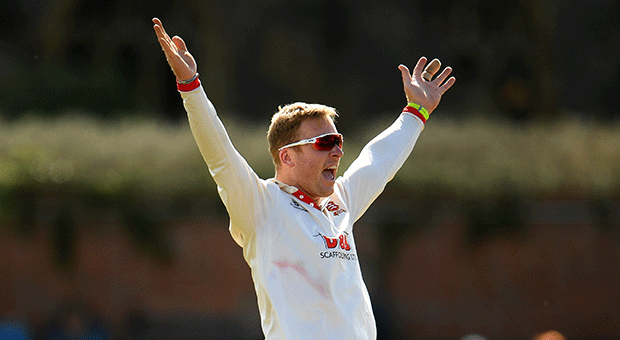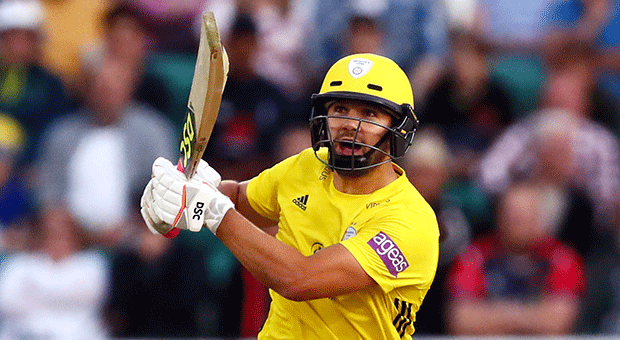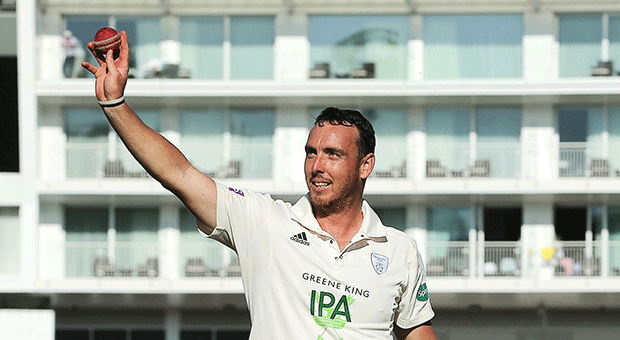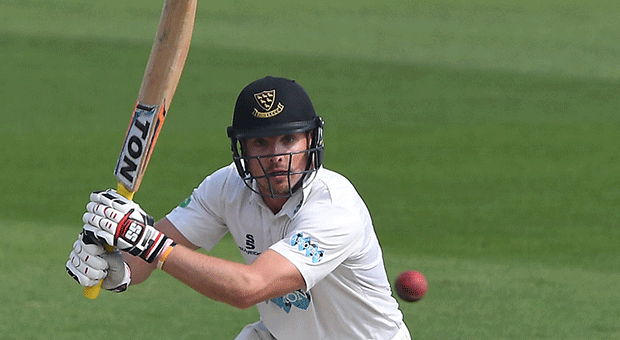It has been a hot-potato topic in South African cricket ever since left-arm spinner Claude Henderson took the plunge in 2004 and became the first Kolpak-registered player in the UK's County Championship.
Now 47, the admirably steady, disciplined but not profoundly world-beating former Boland, Western Province and seven-cap SA Test player - and until fairly recently specialist spin consultant to the Proteas - would give some 10 years of staunch service to Leicestershire, taking advantage of the Kolpak terms allowing non-holders of British passports to play for counties without being specifically deemed overseas players.
They were simply required to come from countries, like South Africa, boasting free trade treaties with the European Union; it was a so obviously appealing way of earning stronger-currency income outside of our domestic summer ... or at least for those willing to play pretty much around-the-clock cricket in separate hemispheres.
A trickle would almost inevitably become a more consistent torrent, particularly (though not exclusively) among players getting just a bit longer in the tooth: Charl Willoughby, Martin van Jaarsveld and Zander de Bruyn in 2005, then the likes of Lance Klusener, Garnett Kruger, Jacques Rudolph ... the pattern only gathered rhythm.
With the rand tottering to an ever-increasing extent against the pound, recent years have only seen a deepening outflow of security-seeking cricketers in the prime, or thereabouts, of their careers ... and an associated hallmark, hardly helped by the proliferation of lucrative Twenty20 leagues planetwide, has been a shrinking stock of "Kolpaks" returning to SA climes routinely to represent local franchises in the established domestic competitions.
That phenomenon, of course, only adds weight to the hard-line theory in some circles that such players shouldn't be welcomed into local systems anyway, especially given South Africa's unique post-apartheid transformation imperatives, both morally and more formally on paper.
It isn't quite so simple, however: in some cases Kolpak players were gradually starting to find themselves cold-shouldered for contractual considerations, or selection, back home: rightly or wrongly, some administrators and observers have not been slow to brand such cricketers disloyal or, in stronger language, even sometimes "mercenaries".
So there is an extremely delicate balancing act at play, featuring a multitude of feelings and opinions.
Yet things are coming toward an intriguing head, too.
In the next few months, and considering Britain's much-debated exit from the EU, there will be a likely nullification of Kolpak contracts, meaning a potential narrowing of options for the many players affected.
Badly crisis-torn only a few months ago and with new key figures in leadership (either acting or permanent) purposefully going about the process of restoring an even keel, Cricket South Africa understandably wants its flagship male and female national teams to lead the way in revival - something that also requires suitable strength and health at the first-class tiers immediately below the international scene and which serve as important feeders to it.
New director of cricket and iconic former Proteas captain Graeme Smith has largely nailed his colours to the mast, enthusing that he sees a reinfusion of Kolpak players into the domestic game, and as fresh candidates for national consideration, as a key method of aiding the renaissance drive.
"With Kolpak coming to an end, the willingness is to always have our best players back in the system," Smith was quoted as saying recently, while adding the proviso that he would wish for a necessary clarity of loyalties.
Severely cash-challenged, which hardly helps, SA's franchise squads for 2020/21 look more collectively callow, arguably, than ever before.
The situation is not helped by the latest wave of outright retirements or late-career switches of landscapes from the already ropey, publicly under-loved domestic system.
Between the likes, for example, of Farhaan Behardien (ending an illustrious 14-year career at the Titans to join Durham, aged 36), Rory Kleinveldt (first-class debut in distant 2002/03, now quitting altogether at 37) and Dane Piedt (new cricketing life in the developing terrain of the United States) you are surrendering an awful lot of time at the crease, overs, runs and wickets ... not to mention invaluable, mentoring on-field whispers in ears.
Several more decorated Proteas stars, too, have only recently cut all - or virtually all - playing ties with their home country to have twilight phases elsewhere: Hashim Amla, Morne Morkel and Vernon Philander spring rapidly to mind.
Again, this a pretty savage loss of intellectual resources ... and it will be just one reason why Smith, and others, back the return of Kolpaks to serve as rebalancers.
Cricketing rookies traditionally don’t prosper at optimal rates of personal knots simply amongst each other: they need what in rugby terms might be branded "hardebaarde" in their midst for educational and other purposes as well.
Not every possibly returning Kolpak player, it is true, would bring the sort of deep value and superstar appeal that occurred in the early post-isolation days when, for instance, a young Shaun Pollock at the Dolphins/KZN enthusiastically fed off the legendary Malcolm Marshall, or someone like Herschelle Gibbs revelled in the two-season presence of Desmond Haynes in the Newlands fold.
But they would help restore a greater sense of steeliness to the domestic scene, and probably also - constructively - break down any delusions of premature grandeur in certain young personnel on franchise books.
A widening of the selection pool in already-proven players would also boost the Proteas cause in all formats: the national side would dearly love to shift notably upward again from current, unusually lowly sixth in the Test rankings and only fair-to-middling fourth in ODIs.
Exactly which Kolpaks, though, might be able to offer the healthy "double" of reinvigorating franchise cricket, standards-wise, and giving a shot in the arm to the Proteas?
A glance at the highest-profile Kolpaks of recent years brings with it the realisation that some, for varying reasons, no longer present sound credentials for any national recall.
Cases in point from an "age-detrimental" perspective, I would argue, include all-rounder David Wiese, who turns 35 this month, left-handed batsman Colin Ingram (34, and who last played for SA in distant 2013) and the wicketkeeper-batsman Dane Vilas, who'll be 35 in our mid-winter.
Then there's someone like Hardus Viljoen, the bustling, one-Test-cap quickie who has ongoing "investment" value at 31, but seems to have settled primarily into roles on the global T20 franchise circuit, far and wide.
It is hard to believe, too, that powerful former javelin star Marchant de Lange, the speed merchant whose Test debut in 2011 saw him bag 7/81 in his maiden bowling innings at that level against Sri Lanka, is still only 29.
He has not needed to be a Kolpak player in county loyalty to Glamorgan because of his wife's British passport, but his injury history includes stress fracture and hamstring issues, which may be one reason why he has become a relatively nomadic figure, preferring the short, sharp formats: De Lange was most recently active for Abu Dhabi in relatively low-gravitas T10 competition.
There's also a complication, it would seem, when it comes to Duanne Olivier, who will only click onward from 27 on Saturday, and who made such a rousing start to his Test career with 48 wickets at 19.25 in his first 10 appearances before his sensational switch of allegiance to a Yorkshire deal.
In doing so, he made a widely-reported statement that raised automatic hackles back home: "Hopefully in the future I can play for England".
It seemed to indicate that Olivier had targeted, instead of further Proteas loyalty, a top-flight return in a different cap; he is expected to fulfil qualification requirements by the start of the 2022 English summer, when he would also only be 29 or an early 30.
Here is a narrowed-down quartet, then, that I believe should be most spiritedly coaxed back into the general SA, but also Proteas-linked fold (in no special order):
Simon Harmer
The wiles of a spinner are particularly renowned for improving with age, and this 31-year-old - not lacking in self-belief or a frank view sometimes - seems to fit into the pattern: he has been a riotous success with Essex. Remember that his
earlier, short spell in Tests for the Proteas was pretty promising statistically, too: 20 wickets at an average of 29 in five matches. Even if the SA brains-trust still intend viewing Keshav Maharaj as their first-choice slow bowler - which would be fair enough at this point - the Proteas badly need a decent off-spinning foil for Tests where more than one tweaker is required and Harmer, who gets good bounce and revolutions on the ball, fits that bill extremely well.
Rilee Rossouw
A sometimes moody, hard-to-predict batsman, the powerful left-hander nevertheless has a reputation for playing really special innings at times; he has the sort of explosiveness when on song to almost match that of AB de Villiers, some six years his senior at 36 and with probably only a very limited future (if at all) for Proteas purposes. While he has not yet been blooded in Tests, Bloemfontein-born Rossouw has a first-class average of almost 41 and his existing ODI and T20 international batting stats are solid, at averages of 38.71 and 29.72 respectively and healthy strike rates in each environment as well.
Kyle Abbott
Yes, the age factor (closing in on 33) is starting to count just a little against him. But Abbott, who has never relied on the most blistering of pace for his success, has an outstandingly willing and reliable engine (he seldom breaks down) and a high work ethic ... he is the sort of seamer you can imagine bustling in with only marginally reduced effectiveness when he is 36 or so, and still richly able to exploit favourable conditions. Above all, he stays an enticing candidate to expand the Proteas' pace cupboard because of his strong record across all three major formats - not something every SA strike factor can boast.
Stiaan van Zyl
Something of a forgotten figure - almost criminally so? - is the now primarily Sussex-based batsman. But Van Zyl, 32, has several years left in his tank, especially if he were to get some belated "love" from his home country. Perhaps some have let slip from their minds that, in six Test knocks in his preferred, more middle-order-geared slots away from an opening berth (where he's been pressed into duty several times), the patient and technically correct southpaw player averages 47.8, as opposed to his admittedly humdrum-looking figure overall of 26.33. I do suspect he may be worth another look, if that can come to fruition, in the not exactly flourishing SA middle berths in the five-day arena. A further string to the Capetonian's bow is that he bowls tight, if unspectacular medium-pacers ... a handy attribute at times (quite often) when the Proteas field only four-strong frontline attacks and could do with some Hansie Cronje-like extra input from someone.
All images: Getty
*Follow our chief writer on Twitter: @RobHouwing




 Publications
Publications
 Partners
Partners


















